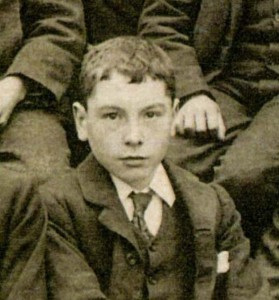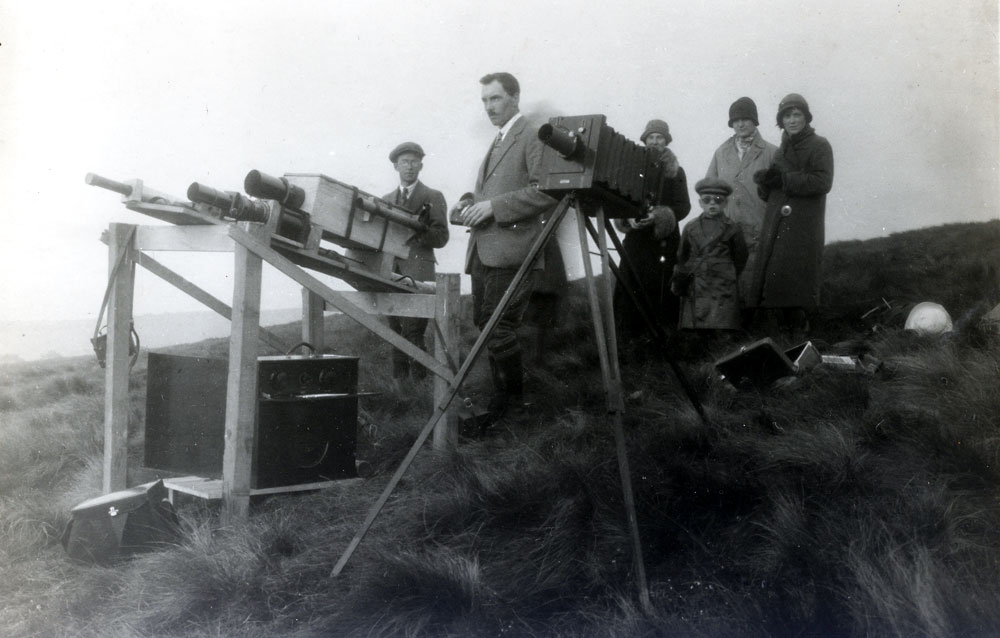
Cyril and Alwyne Walmesley were two young professional Quakers from Lancaster whose lives would change dramatically with the outbreak of war in 1914. Both men shared strong religious beliefs. However, their approach to the war and the way each reconciled their Quaker belief in non-violence with their response to Britain’s involvement in the war differed. Alwyne took an absolutist stance, opting for imprisonment rather than involvement with the Friends Ambulance Unit, an alternative service to which he was conscripted as a religious conscientious objector. Cyril, on the other hand, chose to undertake work with the Friends War Victims Relief Committee, alleviating the suffering of people in war-torn France.
The Walmesley Brothers: Cyril Walmesley
Posted by Caroline Morrison and Janet Nelson
The Early Years
Cyril Walmesley was born in Lancaster on 4th April 1890 to James and Caroline Walmesley. James was the head at the Friends School in Lancaster. Cyril studied, with his younger brother Alwyne, at their parents’ school and later at Ackworth School, an independent Quaker boarding school in Yorkshire. On leaving school he became a trainee to the Borough Surveyor and Water Engineer at Lancaster Corporation, qualifying as a civil engineer.
Cyril’s Response To War
At the outbreak of war Cyril was working for the Fylde Water Board as assistant engineer on the construction of the Grizedale Lea Reservoir at Barnacre near Garstang. His work experience was to prove of great importance during the war. From evidence based on Quaker records and local newspapers, it is possible to trace some of Cyril’s activities during the war, although in the absence of any personal letters it is impossible to know Cyril’s mind at the time.
Cyril did not wait for the introduction of conscription in January 1916 but volunteered his services to the Friends’ War Victim Relief Committee (FWVRC), going out to France in May 1915 in a group of 8 volunteers (The Friend, 7th May 1915). This Committee aimed to help non combatants who were suffering as a result of the fighting. The FWVRC worked at the request of the French local authorities. Although there are no reports of his activities until March 1916 one can surmise that he was engaged in work overseeing the construction of huts and on services such as water and drainage in the towns and villages in which the FWVRC were working at that time.
It appears Cyril worked as part of a team of three, all of whom had experience in civil or mechanical engineering or architecture. They worked together in the planning and design of many of the projects the FWVRC were involved in from 1916 – 1919 in northern France. This meant that Cyril worked in different areas at different times, planning and supervising ongoing works in various places over this period. We know from sources such as the Quaker magazine, The Friend, and internet sources that Cyril was engaged in work in Rheims, Les Fosses and Verdun.
Cyril did not wait for the introduction of conscription in January 1916 but volunteered his services to the Friends' War Victim Relief Committee (FWVRC), going out to France in May 1915 in a group of 8 volunteers (The Friend, 7th May 1915).
The Tribunal
Whilst Cyril was in France the Military Service Act came into force and tribunals were set up for men to appeal against conscription to the armed forces. Under the conscience clause it was possible to request exemption on certain grounds, including religious. Cyril’s tribunal was on 14th March 1916 at Lancaster Town Hall. As he was in France at that time, he asked a fellow Lancastrian Quaker, J. R. Howson, to speak for him, putting forward a plea of conscientious objection. The chairman said it was unnecessary to speak for him as he was one of those who was already engaged in work of good intent. Cyril was granted exemption as long as he remained with the FWVRC, which he did until 1919 (Lancaster Guardian, 18th March 1916).
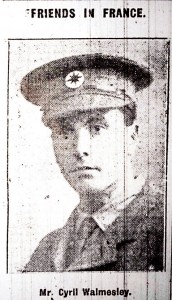
Feature on Cyril Walmesley’s work in France with the Friends War Victims Relief Committee in the Lancaster Guardian, January 1918.
Cyril was posted to Rheims in March 1916 (The Friend, 22nd March 1918) in order to supervise the design and repair of the Civil Hospital which had been badly damaged by German shells. The city was under continual bombardment during the reconstruction and must have been very difficult and stressful for those working on the building. The Lancaster Guardian has an article and a photograph of Cyril in his uniform of the FWVRC stating: ‘Mr C. Walmesley, a Lancastrian, though living in considerable danger was doing very efficient work in repairing a hospital damaged by the German bombardment’ (Lancaster Guardian, 26th January 1918).
Working in France
Whilst work continued in Rheims, Cyril moved to Les Fosses near Troyes in the L’Aube area sometime at the end of the summer 1916 in order to take charge of the repairs and alterations of the buildings of an orphanage belonging to a Protestant ‘colony’ run on utopian principles (for information see example here). The owner, Paul Passy, had asked the FWVRC for help with the renovations. Cyril had a team of six men working under him. (The Friend, 3rd November 1916) The months spent at Les Fosses must have provided a pleasant interlude from the continual bombardments in Rheims. An article written by one of the members of the team for The Friend is headed ‘An Experiment in Practical Socialism.’ He wrote: ‘We feel it is great privilege to be working for such practical idealists as M. And Mme. Passy and greatly enjoy the simple meetings held in their house each Sunday’ (The Friend, 29th September 1916).
'Mr C. Walmesley, a Lancastrian, though living in considerable danger was doing very efficient work in repairing a hospital damaged by the German bombardment' (Lancaster Guardian, 26th January 1918).
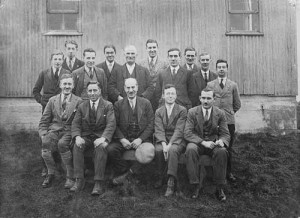
Cyril Walmesley (front row, far right) as water engineer at Stocks Reservoir, 1930. Photograph courtesy of the copyright holder and – www.dalehead.org Dalehead & Stocks in Bowland
Cyril’s final posting was to Verdun at the end of the war. By 1918 the French local authorities at Verdun were already looking to the reconstruction of the rural areas around their town, which had been devastated by four years of war. Most of the population had fled. They invited the FWVRC to take charge of the work in one of the most damaged sections in the area. The French required a rapid programme of building. They needed houses which were easy to build, avoided the use of scarce materials and which could be easily converted into outbuildings at a later time. During 1918, Cyril designed concrete houses which met these needs.
Cyril remained in France until 1919 working with the FWVRC. It is impossible to know if he witnessed the completion of all the projects in which he was involved but what is certain is that his contribution to the reconstruction and to alleviating the sufferings of the people caught up in the war torn areas is great. He clearly lived his life according to his Christian principles and felt no conflict between working in the areas devastated by war and his Quaker belief in non-violence. This was unlike his brother Alwyne who, after spending time with the Friends Ambulance Unit in France, maintained an absolutist stance until the end of the war, enduring two terms in prison for this position.
He clearly lived his life according to his Christian principles and felt no conflict between working in the areas devastated by war and his Quaker belief in non-violence.
After the War
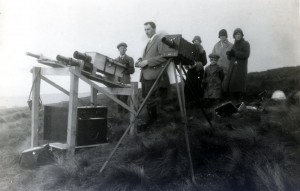
Cyril Walmesley and group photographing the eclipse of the sun, 1927. Photograph courtesy of the copyright holder and – www.dalehead.org Dalehead & Stocks in Bowland
After the war Cyril rejoined Fylde Water Board, later moving to Perth, Scotland to take up a position as water engineer. He contributed several technical papers and in 1931 his standing within the profession was recognised when he was named as a member of the first national panel of engineers authorised to carry out safety inspections of reservoirs under the new 1930 Reservoirs (Safety Provisions) Act (The London Gazette, 13th March 1931). He was also a keen photographer, both in his work and for pleasure, as the image below illustrates.
Cyril married and had a family. His son, Gerard, served in the Friends Ambulance Unit in the Second World War. Cyril remained true to his Quaker faith until his death in 1956. In his obituary which appeared in The Friend on 4th May 1956 Cyril is remembered ‘with affectionate gratitude [for his] unassuming integrity and quiet friendliness.’
- Special thanks go to Ackworth School and the creators of the Dalehead & Stocks in Bowland website for their help with the research for this article.


